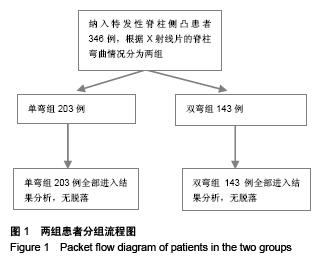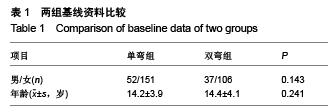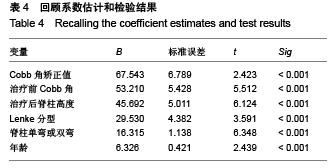| [1] 刘巍,陈庆贺.青少年特发性脊柱侧凸的手术治疗[J].中国矫形外科杂志,2010,18(5):405-408.
[2] Chen ZQ, Zhao YF, He SS, et al. Factors as predictors for thoracic and thoracolumbar/lumbar structural curves in adolescent idiopathic scoliosis. Chin Med J (Engl). 2012; 125(8):1439-1442.
[3] 李世昊,邓强,荀传辉,等.青少年特发性脊柱侧凸植入物内固定后冠状面失平衡及模型构建[J].中国组织工程研究,2014,3(9): 1362-1367.
[4] 刘巍,陈庆贺,王仑,等.柳思羽.哈尔滨市青少年脊柱侧凸普查与支具治疗结果分析[J].中国矫形外科杂志,2011,19(15): 1244-1247.
[5] Tao FH,Wang ZW, Li M, et al. A comparison of anterior and posterior instrumentation for restoring and retaining sagittal balance in patients with idiopathic adolescent scoliosis. J Spinal Disord Tech. 2012;25(6):303-308.
[6] 张兴,邱勇,朱锋,等.胸廓成形对脊柱侧凸患者后路矫形术后肺功能的影响[J].中国脊柱脊髓杂志,2011,21(9):736-739.
[7] 黄爱兵,邱勇,钱邦平,等.特发性与先天性脊柱侧凸患者肺功能障碍的差异性比较[J].中国脊柱脊髓杂志,2008,18(7):512-516.
[8] 赵志,刘泉.青少年特发性脊柱侧凸的最新研究进展[J].中华全科医学,2013,(12):1939-1941.
[9] 王智伟,邱旭升,王渭君,等.青少年特发性脊柱侧凸交感神经系统活性左右侧对称性的观察[J].中国脊柱脊髓杂志,2014,24(10): 923-927.
[10] Grauers A, Rahman I, Gerdhem P. Heritability of scoliosis. Spine Eur. 2012;21(6):1069-1074.
[11] 王斌,孙超,邱勇,等.青少年特发性脊柱侧凸支具治疗结束后近期矫正丢失及影响因素[J].中国脊柱脊髓杂志,2010,20(5): 371-375.
[12] 贺尧,李凯,赵胜,等.儿童脊柱侧凸非融合手术治疗的发展及现状[J].中国组织工程研究,2013,17(17):3174-3183 .
[13] 贺宝荣,许正伟,闫亮,等.青少年脊柱后凸畸形后路截骨矫形术后发生近端交界性后凸的临床研究kyphosis[J].中华解剖与临床杂志,2014,10(4):280-284.
[14] 于斌,王以朋,邱贵兴,等.术前支具治疗对女性青少年特发性脊柱侧凸患者手术矫形效果的影响[J].中国脊柱脊髓杂志, 2012 , 22(8): 712-716.
[15] 陈日高,宋跃明,刘立岷,等.一期前路半椎体切除后路矫形治疗先天性脊柱侧凸[J].中国脊柱脊髓杂志,2008,18(6):447-450.
[16] 彭焰,黄东生,王其杰.前路胸腔镜矫形内固定对特发性脊柱侧凸躯干旋转的矫正效果[J]. 中山大学学报(医学科学版),2013, 34(1):114-117.
[17] 杨光辉,周春光,安永刚,等.前路小切口顶椎切除联合后路矫形手术治疗重度僵硬性脊柱侧凸[J].华西医学,2013,28(7): 1003-1007.
[18] 钱邦平,毛赛虎,孙旭,等.后路矫形手术对青少年特发性脊柱侧凸患者脊柱高度的影响[J]. 中国脊柱脊髓杂志,2013,23(8): 694-699.
[19] 李道文,方俊峰,王丹,等.单纯后路矫形内固定治疗退变性腰椎侧凸[J].临床医学工程,2013,20(9):1135-1136.
[20] 龙智生,陈钢,陈宗和,等.内固定物置入分期矫形治疗重度僵硬脊柱侧凸[J].中国组织工程研究,2013,17(43):7527-7533.
[21] 杨晓霞,刘国辉,张鹏,等.中华长城内固定系统后路矫形治疗青少年特发性脊柱侧凸的护理[J].护理学杂志,2009,24(12):40-41.
[22] 杨贵成.前路松解联合后路矫形固定治疗重度脊柱侧凸[J].中国骨伤,2009,29(10):781-782.
[23] 于海泉,沈建雄.脊柱侧凸后路矫形融合术后深部感染的治疗[J].中国骨与关节外科,2013,6(S1):39-43.
[24] 刘立岷,宋跃明,周忠杰,等.前路胸腔镜下松解联合后路矫形对特发性脊柱侧凸患者肺功能早期影响的研究[J].中国修复重建外科杂志,2012,26(1):70-73.
[25] 马维虎,廖旭昱,刘观燚,等.双侧肋骨截骨结合后路矫形固定治疗重度僵硬性脊柱侧凸[J]. 中国骨与关节损伤杂志,2012,27(5): 409-411.
[26] 刘祥胜,吴冰,魏显招,等. Lenke 2型特发性脊柱侧凸三维矫形手术的有限元模拟[J].第二军医大学学报,2012,33(7):732-737.
[27] 李志钢,宋建东,李海东,等.特发性脊柱侧凸后路选择性腰弯矫形术后出现近端交界性后凸的临床研究[J].实用医学杂志,2012, 41(15):2531-2534.
[28] 张国莹,张永刚,张雪松,等.特发性脊柱侧凸多节段Ponte截骨术对恢复胸椎后凸的疗效[J].中国修复重建外科杂志,2012,26(10): 1197-1201.
[29] 闵理,刘立岷,宋跃明,等.不同种类骨移植在青少年特发性脊柱侧凸后路矫形术中的中长期疗效评价[J].中国骨与关节外科,2012, 5(5):382-388.
[30] 王文军,宋西正,晏怡果,等.改良Halo-骨盆架在重度僵硬性脊柱侧凸矫形中的应用及牵引能力评价[J].中国矫形外科杂志,2011, 27(7):608-610.
[31] 张兴,邱勇,朱锋,等.胸廓成形对脊柱侧凸患者后路矫形术后肺功能的影响[J].中国脊柱脊髓杂志,2011,21(9):736-739.
[32] 张乐,欧云生,权正学,等.后路矫形侧连续置钉矫形结合n-HA/PA66人工骨粒植骨治疗青少年特发性脊柱侧凸[J].重庆医科大学学报,2011,37(12):1464-1467.
[33] 邹健,卢国樑,冯永洪.后路矫形融合术治疗退行性脊柱侧凸的疗效分析[J].中国医药指南,2014,12(33):115-116.
[34] 周恒才,朱锋,邱勇,等.Bending片在预测退变性脊柱侧凸矫形效果中的作用[J].中国矫形外科杂志,2015,31(3):197-201.
[35] 邢泽军,仉建国,于斌,等.青少年特发性脊柱侧凸后路矫形后远端交界区变化[J].中国脊柱脊髓杂志,2010,20(1):29-33.
[36] 周春光,刘立岷,宋跃明,等.重度僵硬性特发性脊柱侧凸患者术后肺功能变化[J].中国修复重建外科杂志,2010,24(1):23-26.
[37] 方秀统,李明,赵颍川,等.连续置钉或间隔置钉矫治LenkeⅠ型青少年特发性脊柱侧凸的效果[J].中国脊柱脊髓杂志,2010,20(5): 367-370.
[38] 邱勇.提高对Ⅰ型神经纤维瘤病性脊柱侧凸后路矫形椎弓根螺钉误置的认识[J].中国脊柱脊髓杂志,2010,20(5):353-355.
[39] 朱泽章,邱勇,王斌,等.严重脊柱侧凸患者围手术期并发症及其预防[J].中国脊柱脊髓杂志,2004,14(4):34-36+40.
[40] 王芃. 1例严重先天性脊柱侧凸经前路椎体切除松解后路矫形的护理[J].中国实用护理杂志,2004,20(19):55-56.
[41] Minoshima R, Kosugi S, Nishimura D, et al. Intra- and postoperative low-dose ketamine for adolescent idiopathic scoliosis surgery: a randomized controlled trial. Acta Anaesthesiol Scand. 2015;59(10):1260-1268.
[42] Liang W, Yu B, Wang Y, et al. Comparison of posterior correction results between Marfan syndrome scoliosis and adolescentidiopathic scoliosis-a retrospective case-series study.J Orthop Surg Res. 2015;10:73.
[43] Namikawa T, Matsumura A, Kato M, et al. Radiological assessment of shoulder balance following posterior spinal fusion for thoracicadolescent idiopathic scoliosis. Scoliosis. 2015;10(Suppl 2):S18.
[44] Tamai K, Terai H, Toyoda H, et al. Which is the best schedule of autologous blood storage for preoperative adolescent idiopathicscoliosis patients? Scoliosis. 2015;10(Suppl 2):S11.
[45] Fu J, Liu C, Zhang YG, et al. Three-dimensional computed tomography for assessing lung morphology in adolescent idiopathicscoliosis following posterior spinal fusion surgery. Orthop Surg. 2015;7(1):43-49.
[46] Okada E, Watanabe K, Pang L, et al. Posterior correction and fusion surgery using pedicle-screw constructs for Lenke type 5Cadolescent idiopathic scoliosis: a preliminary report. Spine (Phila Pa 1976). 2015;40(1):25-30. |



.jpg)


.jpg)